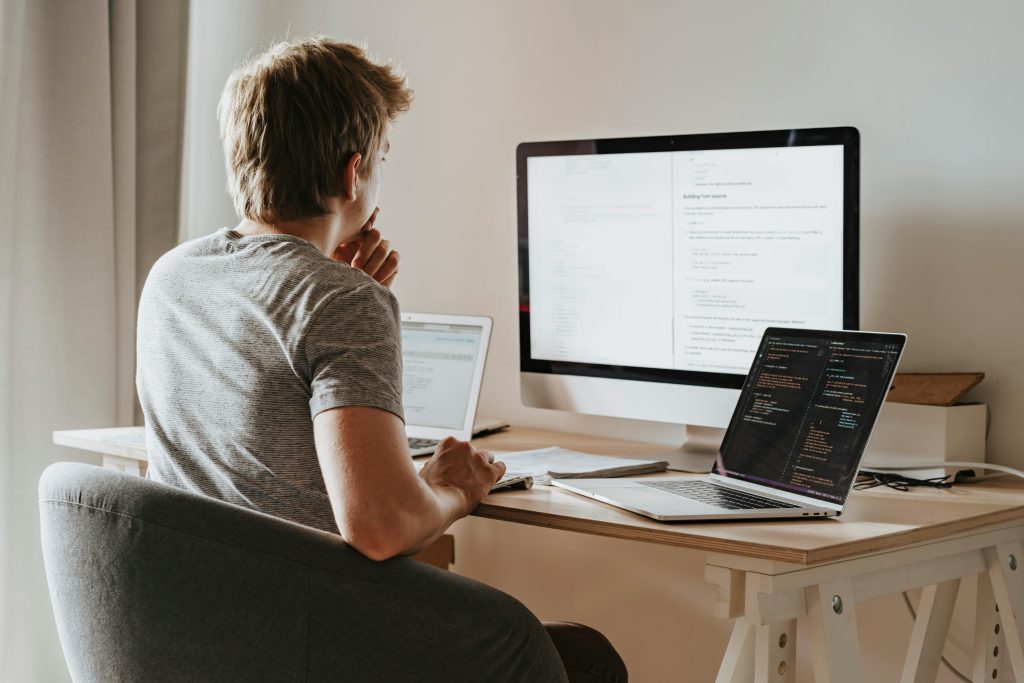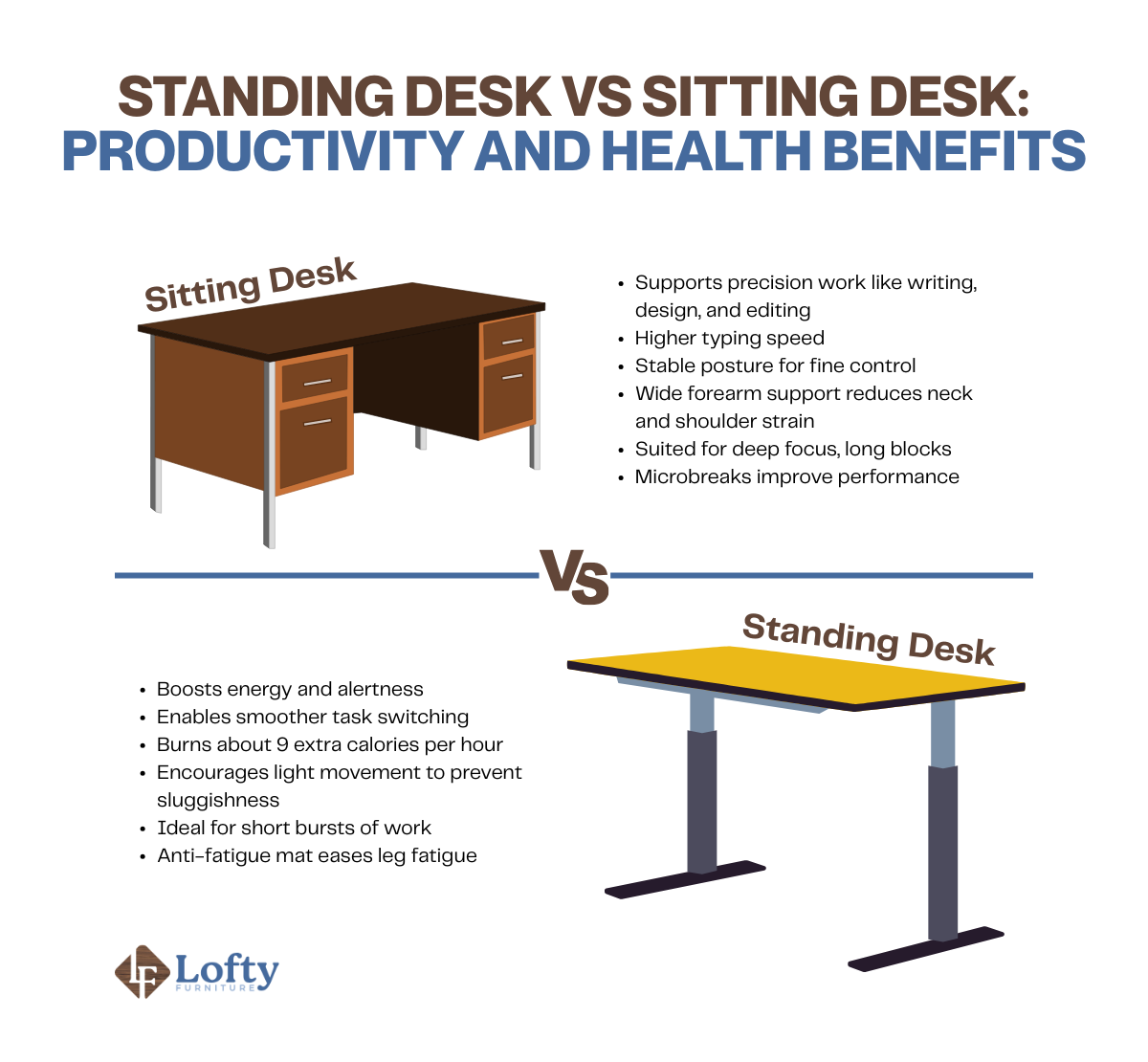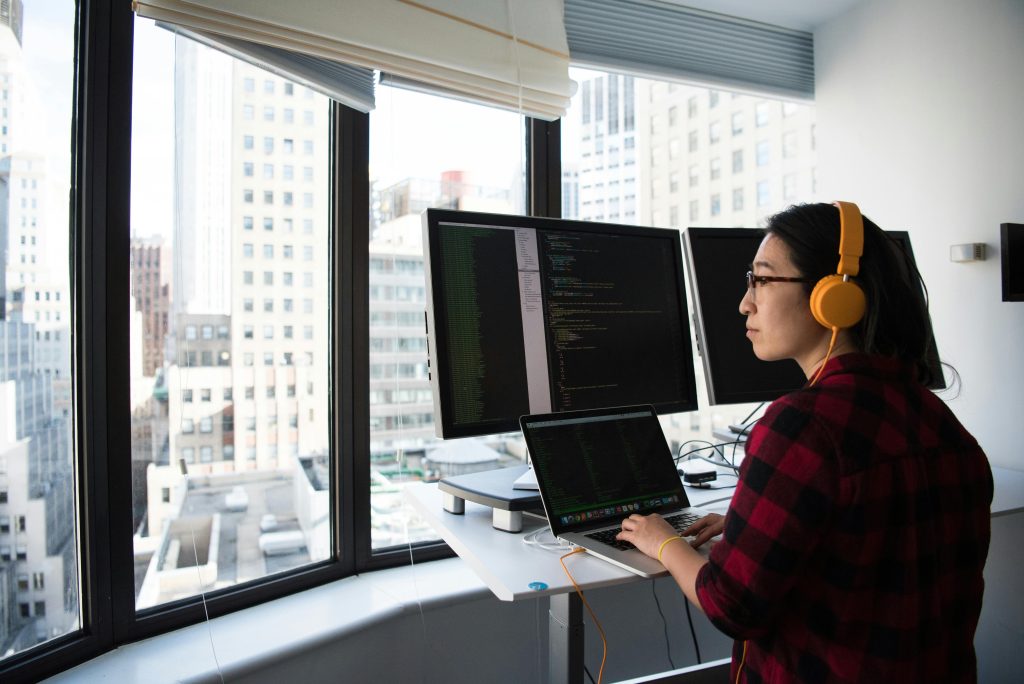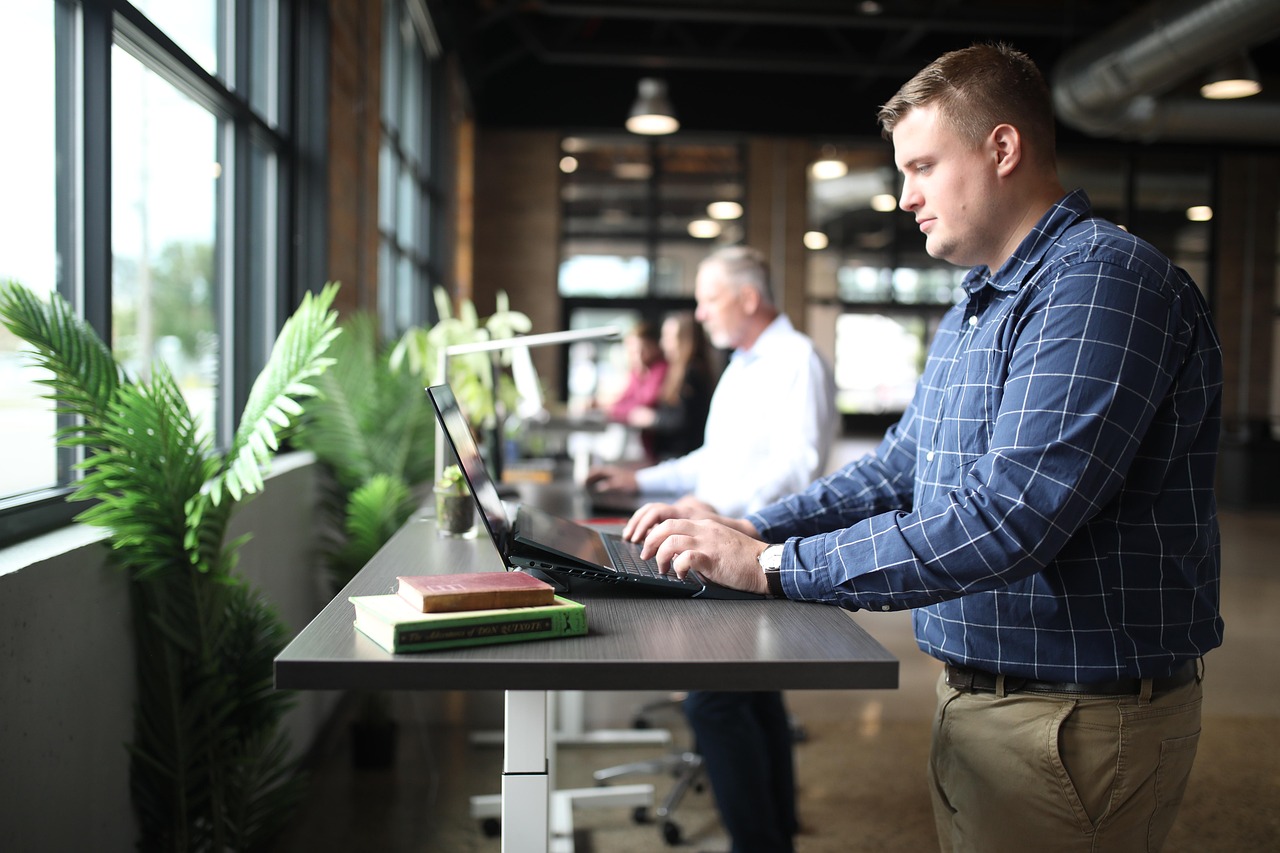Working from home means your desk is where most of your work happens, but it can also be where your energy fades and your focus slips. Whether you are designing, writing, or brainstorming, how you position yourself—sitting or standing—can make a big difference in your productivity and comfort throughout the day.
Key Takeaways:
- Standing desks reduce sedentary time for better health, while sitting desks offer a classic, fixed setup—choose based on your work style.
- Keep elbows at 90°, wrists neutral, eyes level; use sturdy desks, anti-fatigue mats, and supportive shoes for comfort.
- Organize tools within reach, save height presets, and choose durable desks that grow with your setup.
This article explains how to match posture to task, when to sit versus stand, how to switch without breaking concentration, and the simple ergonomics that protect your focus and energy.
Why Desk Choice Matters for Remote Workers and Creatives

Working from home means spending hours in front of the same screen, so your desk setup plays a big role in how comfortable and focused you feel all day. Sitting desks keep you stable and support detailed tasks like writing or design, with hips and elbows at 90 degrees for good posture. Standing desks, on the other hand, boost alertness and help you switch between tasks quickly.
Sitting is great for precision, but watch out for slouching. Take regular breaks to stretch and reset. Standing keeps you energized but works best in short bursts, with support like an anti-fatigue mat and comfortable shoes to avoid fatigue. The key is switching between sitting and standing based on what you’re working on—sit for deep focus, stand for brainstorming or quick reviews.
Productivity Benefits of Sitting Desks
Sitting desks remain a strong choice for tasks that demand precision, control, and long periods of focus. When paired with good ergonomics and regular short breaks, they can support productivity while minimizing physical strain.
Precision and Deep Focus
A seated setup naturally supports detailed, high-focus tasks such as writing, coding, or intricate design work. In a randomized clinical trial, participants averaged 42.5 words per minute while seated compared to 39.7 while standing, with similar accuracy. This suggests a slight productivity edge for text-heavy workflows where speed and precision matter.
Ergonomics and Long-Term Comfort
Sitting allows for a stable posture, especially when paired with ergonomic equipment. A year-long randomized trial of call-center operators found that wide forearm support significantly reduced neck and shoulder pain while helping prevent new upper-body musculoskeletal issues.
Microbreaks for Sustained Performance
Even in seated work, movement matters. A 2022 systematic review and meta-analysis confirmed that brief, regular microbreaks—just one to two minutes per hour—help maintain performance and support physical well-being over long sessions. These short pauses ease tension and refresh focus, making seated productivity more sustainable.
Productivity Benefits of Standing Desks
Standing desks can do more than just get you on your feet; they can help sharpen focus and make your workflow feel more dynamic. From boosting alertness to easing task switching, they offer real benefits for remote workers and creatives.
Boosts Alertness and Mental Agility
Standing naturally increases alertness, making it easier to stay engaged during fast-paced tasks like brainstorming, quick reviews, or light admin work. Many remote workers report feeling more energized and mentally “on” when upright, especially during midday dips in focus.
Aids Task Switching and Flow
Because standing encourages light movement, it supports rapid context switching—useful when jumping between tabs, apps, or tasks. This fluidity helps maintain momentum without the sluggishness that sometimes sets in after long seated sessions.
Burns More Calories Than Sitting
According to a meta-analysis of 46 studies, standing burns roughly 0.15 more kilocalories per minute than sitting—around 9 extra calories per hour. While not a major fitness boost on its own, it adds up over weeks and supports a less sedentary lifestyle.
Reduces Physical Strain with Proper Support
Standing for long periods without support can lead to fatigue, especially in the lower limbs. An anti-fatigue mat helps distribute pressure evenly, reduces discomfort, and encourages gentle movement, making standing more sustainable during longer sessions.

How to Choose the Right Desk for Your Workflow
Your desk should support how you work. Choose a setup that lets you shift easily between focused tasks and creative work. The right desk keeps your energy and focus steady throughout the day.
Plan Your Week and Choose Modes
Break down your weekly tasks: deep focus vs. quick tasks. Sit for detailed work, stand for fast-paced reviews or brainstorming. Most people benefit from 2–4 hours of standing daily, with breaks. Make sure your desk fits your height and keeps your equipment stable.
Dial In Ergonomics and Stability
Use a supportive chair and solid desk. For standing setups, smooth height changes and a wobble-free frame are key. Keep elbows at 90°, wrists straight, and your screen at eye level. Height-adjustable desks help reduce sitting time over the long term.
Set Up for Effortless Switching and Future Growth
Make posture changes effortless. Keep tools within reach, manage cables neatly, and save height presets. Choose a desk that can grow with your needs—supporting more gear, heavier monitors, and offering solid long-term reliability.
Settle the standing desk vs sitting desk debate with the Amish Smart Desk. Handcrafted hardwood, quiet height adjustments, and rock-solid stability for enhanced productivity.
Best Practices for Using Sit-Stand Desks

Create a simple rhythm by switching between sitting and standing every 40 to 50 minutes, using gentle cues like a soft chime or task completion as your signal. Take quick breaks to roll your shoulders, stretch your ankles, look away from the screen, and breathe deeply to stay fresh and reduce stiffness.
Match your tasks to your posture: stand for brainstorming, drafting, or quick notes; sit for editing, polishing, and detailed work. Keep your setup seamless by saving height presets, maintaining consistent keyboard and monitor positions, and using accessories like a laptop stand, anti-fatigue mat, and supportive shoes. Plan your day to flow naturally between sitting and standing, adjusting based on your energy and focus.
Learn more where to buy ergonomic Amish desks online.
Conclusion
Productivity improves when your workspace matches how you work. Sitting supports detailed, focused tasks, while standing helps with energy and quick changes. Switching between sitting and standing can reduce strain and keep your focus steady. When your desk setup aligns with your work habits, it’s easier to maintain both comfort and productivity throughout the day.
A well-designed sit-stand desk offers stability, smooth height adjustments, and enough space for your tools, making it easier to switch positions without breaking concentration. This kind of setup supports a natural flow between precision work and creative bursts.
Frequently Asked Questions
How often should you switch between sitting and standing?
Switch every 40 to 50 minutes or at natural task breaks to avoid fatigue and maintain focus. Regular movement is more important than long periods in one position.
Do you burn more calories at a standing desk?
Yes, standing burns slightly more calories—about 9 extra per hour compared to sitting. It’s a small difference but can add up over time when combined with other movement.
Do doctors recommend standing desks?
Many health professionals support using wood standing desks as part of reducing sedentary behavior. However, they emphasize alternating between sitting, standing, and moving for the best results.
Are standing desks good for your knees?
Standing with locked knees can lead to discomfort. Maintain a soft bend, shift your weight, and move slightly. A supportive mat reduces pressure on joints. If you have a history of knee pain, spread your standing sessions across shorter periods and incorporate small motion breaks. If pain persists, shorten standing blocks.
